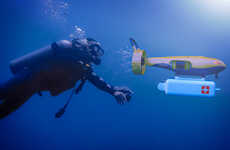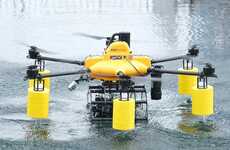
The 'Draper' Autonomous Underwater Vehicle Works to Clean the Ocean
Michael Hemsworth — February 5, 2020 — Tech
References: sprout.cc & yankodesign
The conceptual 'Draper' autonomous underwater vehicle is a futuristic piece of equipment that would help to solve the issue of the rising amount of microplastic in our oceans and waterways. Designed by Sprout Studios for Draper, the drone highlights the ability to easily traverse through the water to collect samples to analyze just how much plastic material might be present. This information can then be utilized to find high concentrations to help researchers on land figure out how to stop additional plastic from getting into the environment.
The conceptual 'Draper' autonomous underwater vehicle was explained further by Sprout Studios which said, "Draper’s AUV can detect and analyze invisible microplastics, and enable scientists to understand where they are originating from, where they are most prominent, and how to prevent them from contaminating our waters. When the AUV is deployed, it skims the top nine meters of the water where most microplastics are located, scanning for microplastics, testing for specific types, and ultimately relaying GPS coordinates into a heat map."
The conceptual 'Draper' autonomous underwater vehicle was explained further by Sprout Studios which said, "Draper’s AUV can detect and analyze invisible microplastics, and enable scientists to understand where they are originating from, where they are most prominent, and how to prevent them from contaminating our waters. When the AUV is deployed, it skims the top nine meters of the water where most microplastics are located, scanning for microplastics, testing for specific types, and ultimately relaying GPS coordinates into a heat map."
Trend Themes
1. Autonomous Underwater Vehicles - The rise of autonomous underwater vehicles presents an opportunity for the development of innovative solutions to clean up microplastics in the ocean.
2. Microplastic Detection Technology - Advancements in microplastic detection technology enable researchers to analyze the presence and origin of microplastics, leading to more effective prevention strategies.
3. Environmental Monitoring Drones - The use of drones for environmental monitoring, such as detecting and preventing plastic contamination in waterways, opens up avenues for targeted interventions and pollution prevention.
Industry Implications
1. Marine Technology - The marine technology industry can leverage autonomous underwater vehicles to develop efficient methods for collecting and analyzing microplastics, contributing to cleaner oceans.
2. Environmental Monitoring - The environmental monitoring industry can capitalize on advancements in microplastic detection technology to offer comprehensive solutions for tracking and managing plastic contamination in various ecosystems.
3. Drone Technology - The drone technology industry has an opportunity to create specialized drones for monitoring and cleaning up plastic pollution, showcasing their versatility in addressing environmental challenges.
6.4
Score
Popularity
Activity
Freshness























